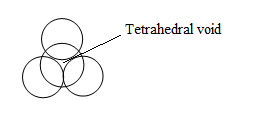
In the spinel structure, oxides ions are cubically-closed packed whereas ${{\dfrac{1}{8}}^{th}}$of tetrahedral voids are occupied by ${{A}^{2+}}$cation and half of octahedral voids are occupied by ${{B}^{3+}}$cations. The general formula of compound having spinel structure is:
(1) ${{A}_{2}}{{B}_{2}}{{O}_{4}}$
(2) $A{{B}_{2}}{{O}_{4}}$
(3) ${{A}_{2}}{{B}_{4}}{{O}_{2}}$
(4) ${{A}_{4}}{{B}_{2}}{{O}_{2}}$
Answer
571.8k+ views
Hint: Generally, tetrahedral voids are two times octahedral voids in cubic close packed structures.
Complete step by step solution:
Let us first understand about the packed structures and voids present within them.
Cubic close packed structures-
The cubic close packed structure consists of four layers of atoms per unit cell. There are two types of arrangement of atoms in the structure i.e. Simple cubic arrangement and Hexagonal cubic arrangement.
Simple cubic arrangement has the same layer of atoms arranged layer by layer one above the other in a definite manner.

Hexagonal cubic arrangement has one layer in the depression of another layer, repeating over one another.

There are two types of gaps (commonly known as voids) within them;
Tetrahedral void-
These are mostly found in CCP and are triangular in shape with coordination number of 4.

Tetrahedral voids are two times the number of atoms in the unit cell.
Octahedral void-
These are mostly found in HCP and are octahedral in shape with coordination number of 6.

Octahedral voids are equal to the number of atoms in the unit cell.
Thus,
Tetrahedral voids are two times the octahedral voids.
Spinel group-
These are the group of minerals with general formulation $A{{B}_{2}}{{X}_{4}}$.
where,
X is anion
A and B are cations.
Illustration,
Oxides form close packings. Thus, it is an anion.
Whereas, ${{A}^{2+}}$ and ${{B}^{3+}}$ are cations.
Given that,
${{\dfrac{1}{8}}^{th}}$of tetrahedral voids are occupied by ${{A}^{2+}}$cation;
Thus, ${{A}^{2+}}$ ions will be ${{\dfrac{1}{4}}^{th}}$of oxide ions.
And half of octahedral voids are occupied by ${{B}^{3+}}$cations;
Thus, ${{B}^{3+}}$ ions will be $\dfrac{1}{2}$ of oxide ions.
Hence, A:B:O = $\dfrac{1}{4}$: $\dfrac{1}{2}$: 1 = 1:2:4.
Therefore, the formula is $A{{B}_{2}}{{O}_{4}}$.
Option (B) is correct.
Note: In accordance with the hint given, we can ignore option (A) and (D) from the start. Only concentrate on the remaining two options.
Complete step by step solution:
Let us first understand about the packed structures and voids present within them.
Cubic close packed structures-
The cubic close packed structure consists of four layers of atoms per unit cell. There are two types of arrangement of atoms in the structure i.e. Simple cubic arrangement and Hexagonal cubic arrangement.
Simple cubic arrangement has the same layer of atoms arranged layer by layer one above the other in a definite manner.

Hexagonal cubic arrangement has one layer in the depression of another layer, repeating over one another.

There are two types of gaps (commonly known as voids) within them;
Tetrahedral void-
These are mostly found in CCP and are triangular in shape with coordination number of 4.

Tetrahedral voids are two times the number of atoms in the unit cell.
Octahedral void-
These are mostly found in HCP and are octahedral in shape with coordination number of 6.

Octahedral voids are equal to the number of atoms in the unit cell.
Thus,
Tetrahedral voids are two times the octahedral voids.
Spinel group-
These are the group of minerals with general formulation $A{{B}_{2}}{{X}_{4}}$.
where,
X is anion
A and B are cations.
Illustration,
Oxides form close packings. Thus, it is an anion.
Whereas, ${{A}^{2+}}$ and ${{B}^{3+}}$ are cations.
Given that,
${{\dfrac{1}{8}}^{th}}$of tetrahedral voids are occupied by ${{A}^{2+}}$cation;
Thus, ${{A}^{2+}}$ ions will be ${{\dfrac{1}{4}}^{th}}$of oxide ions.
And half of octahedral voids are occupied by ${{B}^{3+}}$cations;
Thus, ${{B}^{3+}}$ ions will be $\dfrac{1}{2}$ of oxide ions.
Hence, A:B:O = $\dfrac{1}{4}$: $\dfrac{1}{2}$: 1 = 1:2:4.
Therefore, the formula is $A{{B}_{2}}{{O}_{4}}$.
Option (B) is correct.
Note: In accordance with the hint given, we can ignore option (A) and (D) from the start. Only concentrate on the remaining two options.
Recently Updated Pages
A man running at a speed 5 ms is viewed in the side class 12 physics CBSE

State and explain Hardy Weinbergs Principle class 12 biology CBSE

Which of the following statements is wrong a Amnion class 12 biology CBSE

Two Planoconcave lenses 1 and 2 of glass of refractive class 12 physics CBSE

The compound 2 methyl 2 butene on reaction with NaIO4 class 12 chemistry CBSE

Bacterial cell wall is made up of A Cellulose B Hemicellulose class 12 biology CBSE

Trending doubts
What are the major means of transport Explain each class 12 social science CBSE

Which are the Top 10 Largest Countries of the World?

Draw a labelled sketch of the human eye class 12 physics CBSE

Explain sex determination in humans with line diag class 12 biology CBSE

Give 10 examples of unisexual and bisexual flowers

State the principle of an ac generator and explain class 12 physics CBSE




